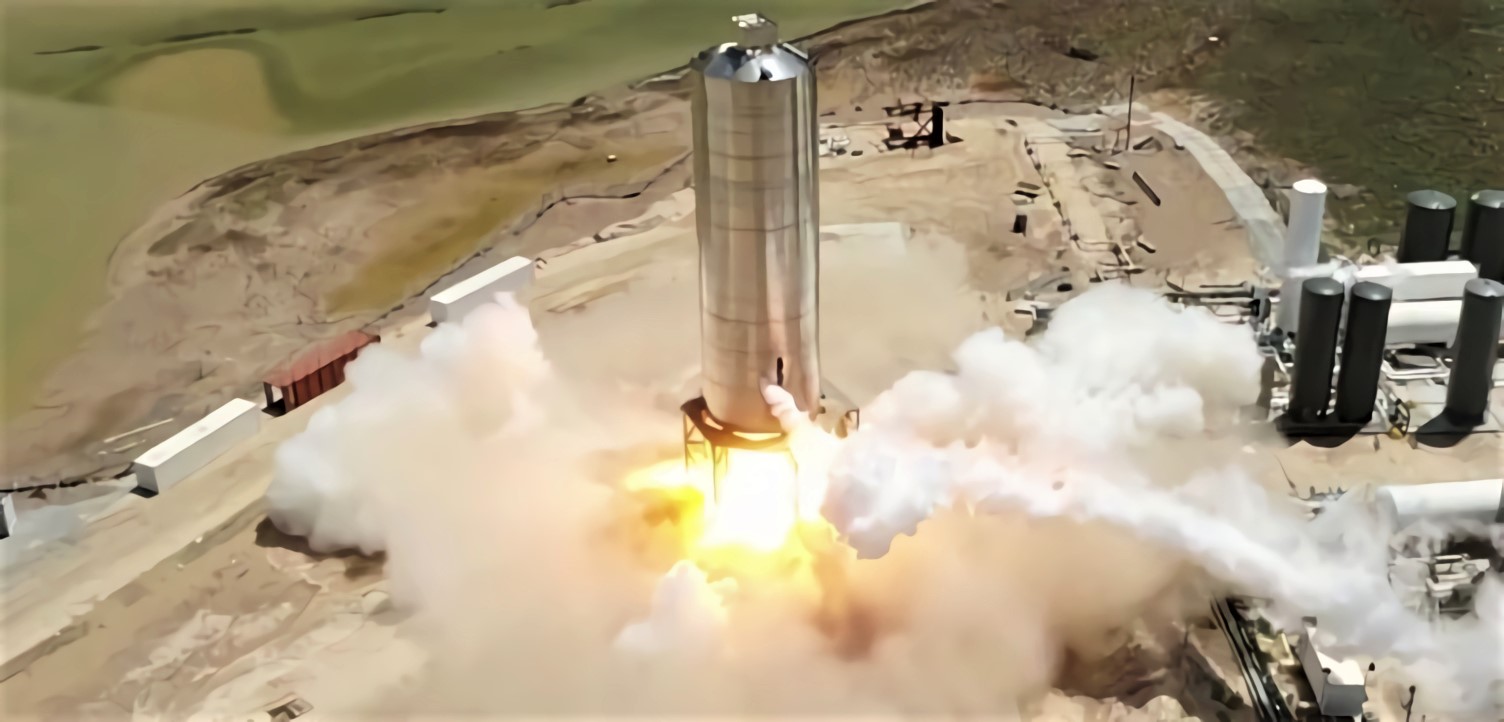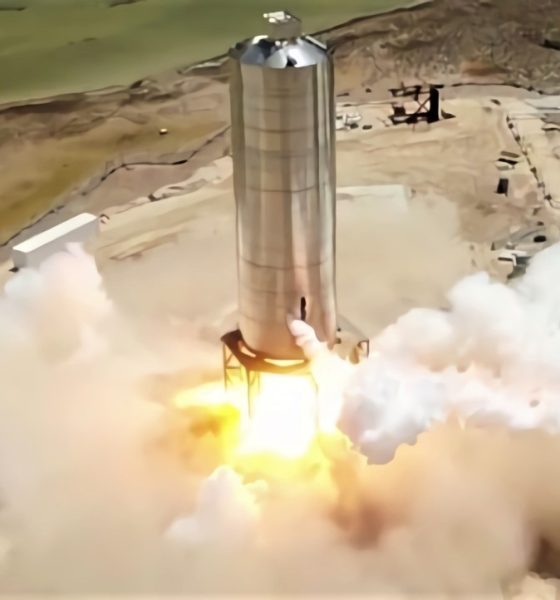

News
SpaceX Starship hop debut aborted at the last second by Raptor engine
SpaceX’s full-scale Starship hop debut was aborted at the last second after an otherwise successful lead-up to the milestone, forcing the company to try again tomorrow.
Following a minor delay from August 2nd to August 3rd, SpaceX kicked off Starship SN5’s hop debut preparations relatively late into the 12-hour window, closing the highway and clearing the pad around 5pm CDT (22:00 UTC). The Starship SN5 tank section prototype was pressurized with ambient-temperature gas around the same time, while cryogenic liquid methane and oxygen propellant loading appeared to begin at roughly 6:20pm CDT (23:20 UTC).
Soon after, SpaceX CEO Elon Musk revealed that Starship was just 33 minutes away from launch, marching towards the first hop of a full-scale prototype at 6:56pm CDT. Unfortunately, possibly much less than a second before ignition, Starship SN5’s Raptor engine had different plans.
Musk says that one of Raptor engine SN27’s “spin start valves” failed to open moments before ignition, causing Starship to automatically abort the attempt. With more than an hour left in the window, SpaceX had time to briefly troubleshoot the bug and potentially turn the rocket around for a second attempt, but Musk announced some 50 minutes later that the company would stand down and try again tomorrow.
Musk’s description of the hop test abort sounds suspiciously similar to his description of the last abort of Starship SN5’s Raptor engine static fire test, in which a “fuel spin valve didn’t open.” If the root cause of both aborts is the same, there’s a good chance that SpaceX may need more time to properly investigate and fix the problem. A recurring issue is immediately much more concerning compared to a one-off bug, so there’s also a chance that SpaceX will go as far as replacing the Raptor engine currently installed on Starship SN5.

If things look more severe than SpaceX initially thought they were after the static fire abort and a replacement engine is necessary, Starship SN5 will have to complete another static fire test with the new Raptor before it can proceed to a second hop attempt.
Based on live views of the launch attempt from NASASpaceflight and LabPadre, Starship SN5 likely aborted a matter of milliseconds before Raptor SN27 ignition and perhaps just a second or two before liftoff. Just like SpaceX’s workhorse Falcon 9 and Heavy rockets, the vehicle’s flight computer is fully in control of the countdown a minute or two before liftoff and can automatically abort far faster than any human could possibly react. Held to the launch mount by hold-down clamps, Starship could have technically analyzed the engine’s performance after ignition and aborted the launch even later into the count.
Once hold-down clamp release is commanded, Starship SN5 will attempt to fly a roughly 150m-tall (500 ft) arc heading southeast of the launch mount. Perhaps 10 seconds prior to touchdown, Starship will attempt to deploy an array of six odd legs and gently land a few hundred feet from the pad. As of now, assuming Raptor’s finicky valve can be easily rectified, SpaceX will work towards a second Starship SN5 hop attempt sometime between 8am and 8pm CDT on Tuesday, August 4th.
Check out Teslarati’s Marketplace! We offer Tesla accessories, including for the Tesla Cybertruck and Tesla Model 3.

News
Tesla FSD fleet is nearing 7 billion total miles, including 2.5 billion city miles
As can be seen on Tesla’s official FSD webpage, vehicles equipped with the system have now navigated over 6.99 billion miles.

Tesla’s Full Self-Driving (Supervised) fleet is closing in on almost 7 billion total miles driven, as per data posted by the company on its official FSD webpage.
These figures hint at the massive scale of data fueling Tesla’s rapid FSD improvements, which have been quite notable as of late.
FSD mileage milestones
As can be seen on Tesla’s official FSD webpage, vehicles equipped with the system have now navigated over 6.99 billion miles. Tesla owner and avid FSD tester Whole Mars Catalog also shared a screenshot indicating that from the nearly 7 billion miles traveled by the FSD fleet, more than 2.5 billion miles were driven inside cities.
City miles are particularly valuable for complex urban scenarios like unprotected turns, pedestrian interactions, and traffic lights. This is also the difference-maker for FSD, as only complex solutions, such as Waymo’s self-driving taxis, operate similarly on inner-city streets. And even then, incidents such as the San Francisco blackouts have proven challenging for sensor-rich vehicles like Waymos.
Tesla’s data edge
Tesla has a number of advantages in the autonomous vehicle sector, one of which is the size of its fleet and the number of vehicles training FSD on real-world roads. Tesla’s nearly 7 billion FSD miles then allow the company to roll out updates that make its vehicles behave like they are being driven by experienced drivers, even if they are operating on their own.
So notable are Tesla’s improvements to FSD that NVIDIA Director of Robotics Jim Fan, after experiencing FSD v14, noted that the system is the first AI that passes what he described as a “Physical Turing Test.”
“Despite knowing exactly how robot learning works, I still find it magical watching the steering wheel turn by itself. First it feels surreal, next it becomes routine. Then, like the smartphone, taking it away actively hurts. This is how humanity gets rewired and glued to god-like technologies,” Fan wrote in a post on X.
News
Tesla starts showing how FSD will change lives in Europe
Local officials tested the system on narrow country roads and were impressed by FSD’s smooth, human-like driving, with some calling the service a game-changer for everyday life in areas that are far from urban centers.

Tesla has launched Europe’s first public shuttle service using Full Self-Driving (Supervised) in the rural Eifelkreis Bitburg-Prüm region of Germany, demonstrating how the technology can restore independence and mobility for people who struggle with limited transport options.
Local officials tested the system on narrow country roads and were impressed by FSD’s smooth, human-like driving, with some calling the service a game-changer for everyday life in areas that are far from urban centers.
Officials see real impact on rural residents
Arzfeld Mayor Johannes Kuhl and District Administrator Andreas Kruppert personally tested the Tesla shuttle service. This allowed them to see just how well FSD navigated winding lanes and rural roads confidently. Kruppert said, “Autonomous driving sounds like science fiction to many, but we simply see here that it works totally well in rural regions too.” Kuhl, for his part, also noted that FSD “feels like a very experienced driver.”
The pilot complements the area’s “Citizen Bus” program, which provides on-demand rides for elderly residents who can no longer drive themselves. Tesla Europe shared a video of a demonstration of the service, highlighting how FSD gives people their freedom back, even in places where public transport is not as prevalent.
What the Ministry for Economic Affairs and Transport says
Rhineland-Palatinate’s Minister Daniela Schmitt supported the project, praising the collaboration that made this “first of its kind in Europe” possible. As per the ministry, the rural rollout for the service shows FSD’s potential beyond major cities, and it delivers tangible benefits like grocery runs, doctor visits, and social connections for isolated residents.
“Reliable and flexible mobility is especially vital in rural areas. With the launch of a shuttle service using self-driving vehicles (FSD supervised) by Tesla in the Eifelkreis Bitburg-Prüm, an innovative pilot project is now getting underway that complements local community bus services. It is the first project of its kind in Europe.
“The result is a real gain for rural mobility: greater accessibility, more flexibility and tangible benefits for everyday life. A strong signal for innovation, cooperation and future-oriented mobility beyond urban centers,” the ministry wrote in a LinkedIn post.
News
Tesla China quietly posts Robotaxi-related job listing
Tesla China is currently seeking a Low Voltage Electrical Engineer to work on circuit board design for the company’s autonomous vehicles.

Tesla has posted a new job listing in Shanghai explicitly tied to its Robotaxi program, fueling speculation that the company is preparing to launch its dedicated autonomous ride-hailing service in China.
As noted in the listing, Tesla China is currently seeking a Low Voltage Electrical Engineer to work on circuit board design for the company’s autonomous vehicles.
Robotaxi-specific role
The listing, which was shared on social media platform X by industry watcher @tslaming, suggested that Tesla China is looking to fill the role urgently. The job listing itself specifically mentions that the person hired for the role will be working on the Low Voltage Hardware team, which would design the circuit boards that would serve as the nervous system of the Robotaxi.
Key tasks for the role, as indicated in the job listing, include collaboration with PCB layout, firmware, mechanical, program management, and validation teams, among other responsibilities. The role is based in Shanghai.
China Robotaxi launch
China represents a massive potential market for robotaxis, with its dense urban centers and supportive policies in select cities. Tesla has limited permission to roll out FSD in the country, though despite this, its vehicles have been hailed as among the best in the market when it comes to autonomous features. So far, at least, it appears that China supports Tesla’s FSD and Robotaxi rollout.
This was hinted at in November, when Tesla brought the Cybercab to the 8th China International Import Expo (CIIE) in Shanghai, marking the first time that the autonomous two-seater was brought to the Asia-Pacific region. The vehicle, despite not having a release date in China, received a significant amount of interest among the event’s attendees.








